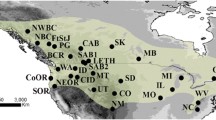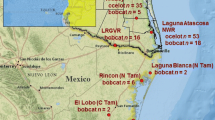Abstract
Natural habitats, and the populations they sustain, are becoming increasingly fragmented by human activities. Parallels between ‘true’ islands and ‘habitat’ islands suggest that standing levels of individual genetic diversity in naturally fragmented populations may predict the genetic fate of their anthropogenically fragmented counterparts, but this hypothesis remains largely untested. We compared neutral-locus genetic diversity of individual song sparrows (Melospiza melodia) breeding in a naturally fragmented landscape (small coastal islands) to that of song sparrows in similar-sized ‘urban islands’ separated by roads and housing developments rather than by water. Individuals on coastal islands were more heterozygous and less inbred than those in urban islands. Estimates of population genetic structuring (assessed by pairwise genetic differentiation and Bayesian clustering methods) and contemporary dispersal (based on assignment tests) revealed little structure within either landscape, suggesting that lack of connectivity at the geographic scale we investigated cannot explain the reduced heterozygosity of urban birds. However, within-site genetic similarity was higher in the urban than the coastal landscape. Assuming that historic genetic diversity was similar in these two environments, our findings suggest that anthropogenically fragmented populations may lose genetic diversity faster than their naturally fragmented counterparts.


Similar content being viewed by others
References
Balmford A, Green RE, Jenkins M (2003) Measuring the changing state of nature. Trends Ecol Evol 18:326–330
Barnett JR, Ruiz-Gutierrez V, Coulon A, Lovette IJ (2008) Weak genetic structuring indicates ongoing gene flow across white-ruffed manakin (Corapipo altera) populations in a highly fragmented Costa Rica landscape. Conserv Genet 9:1403–1412
Blanchet S, Rey O, Etienne R, Lek S, Loot G (2010) Species-specific responses to landscape fragmentation: implications for management strategies. Evol Appl 3:291–304
Brown LM, Ramey RR II, Tamburini B, Gavin TA (2004) Population structure and mitochondrial DNA variation in sedentary Neotropical birds isolated by forest fragmentation. Conserv Genet 5:743–757
Clinchy M, Zanette L, Boonstra R, Wingfield JC, Smith JNM (2004) Balancing food and predator pressure induces chronic stress in songbirds. Proc R Soc Lond B 271:2473–2479
Cornuet JM, Luikart G (1996) Description and power analysis of two tests for detecting recent population bottlenecks from allele frequency data. Genetics 144:2001–2014
Cristecu R, Sherwin WB, Handasyde K, Cahill V, Cooper DW (2010) Detecting bottlenecks using BOTTLENECK 1.2.02 in wild populations: the importance of the microsatellite structure. Conserv Genet 11:1043–1049
Croteau EK, Lougheed SC, Krannitz PG, Mahony NA, Walker BL, Boag PT (2007) Genetic population structure of the sagebrush Brewer’s sparrow, Spizella breweri breweri, in a fragmented landscape at the northern range periphery. Conserv Genet 8:1453–1463
DiRienzo A, Peterson AC, Garza JC, Valdes AM, Slatkin M, Freimer NB (1994) Mutational processes of simple-sequence repeat loci in human populations. Proc Natl Acad Sci USA 91:3166–3170
Falush D, Stephens M, Pritchard JK (2003) Inference of population structure using multilocus genotype data: linked loci and correlated allele frequencies. Genetics 164:1567–1587
Frankham R (1997) Do island populations have lower genetic variation than mainland populations? Heredity 78:311–327
Griffith SC, Stewart IRK, Owens IPF, Dawson DA, Burke T (1999) Contrasting levels of extra-pair paternity in mainland and island populations of the house sparrow (Passer domesticus): is there an ‘island effect’? Biol J Linn Soc 68:303–316
Hanotte O, Zanon C, Pugh A, Greig C, Dixon A, Burke T (1994) Isolation and characterization of microsatellite loci in a passerine bird—the reed bunting Emberiza schoeniclus. Mol Ecol 3:529–530
Hatchwell BJ (2009) The evolution of cooperative breeding in birds: kinship, dispersal and life history. Philos Trans R Soc B 364:3217–3227
Hill CE, Akçay Ç, Campbell SE, Beecher MD (2011) Extrapair paternity, song, and genetic quality in song sparrows. Behav Ecol 22:73–81
Hoffman JI, Forcada J, Amos W (2006) No relationship between microsatellite variation and neonatal fitness in Antarctic fur seals Arctocephalus gazella. Mol Ecol 15:1995–2005
Hubisz MJ, Falush D, Stephens M, Pritchard JK (2009) Inferring weak population structure with the assistance of sample group information. Mol Ecol Resour 9:1322–1332
Jeffery KJ, Keller LF, Arcese P, Bruford MW (2001) The development of microsatellite loci in the song sparrow, Melospiza melodia (Aves) and genotyping errors associated with good quality DNA. Mol Ecol Notes 1:11–13
Keller LF, Arcese P (1998) No evidence for inbreeding avoidance in a natural population of song sparrows (Melospiza melodia). Am Nat 152:380–392
Keller LF, Arcese P, Smith JNM, Hochachka WM, Stearns SC (1994) Selection against inbred song sparrows during a natural population bottleneck. Nature 372:356–357
Keyghobadi N (2007) The genetic implications of habitat fragmentation for animals. Can J Zool 85:1049–1064
Keyghobadi N, Roland J, Matter SF, Strobeck C (2005) Among- and within-patch components of genetic diversity respond at different rates to habitat fragmentation: an empirical demonstration. Proc R Soc Lond B 272:553–560
Lynch M, Ritland K (1999) Estimation of pairwise relatedness with molecular markers. Genetics 152:1753–1766
Lynch J, Whigham DF (1984) Effects of forest fragmentation on breeding bird communities in Maryland. Biol Conserv 28:287–324
MacArthur RH, Wilson EO (1967) The theory of island biogeography. Princeton University Press, Princeton
Milligan BG (2003) Maximum-likelihood estimation of relatedness. Genetics 163:1153–1167
O’Connor KD, Marr AB, Arcese P, Keller LF, Jeffery KJ, Bruford MW (2006) Extra-pair fertilization and effective population size in the song sparrow (Melospiza melodia). J Avian Biol 37:572–578
Paetkau D, Slade R, Burden M, Estoup A (2004) Genetic assignment methods for the direct, real-time estimation of migration rate: a simulation-based exploration of accuracy and power. Mol Ecol 13:55–65
Piry S, Alapetite A, Cornuet JM, Paetkau D, Baudoin L, Estoup A (2004) GeneClass 2: a software for genetic assignment and first-generation migrant detection. J Hered 95:536–539
Porlier M, Bélisle M, Garant D (2009) Non-random distribution of individual genetic diversity along an environmental gradient. Philos Trans R Soc B 364:1543–1554
Potvin DA, MacDougall-Shackleton EA (2009) Parental investment amplifies effects of genetic complementarity on growth rates in song sparrows, Melospiza melodia. Anim Behav 78:943–948
Pruett CL, Arcese P, Chan YL, Wilson AG, Patten MA, Keller LF, Winker K (2008) The effects of contemporary processes in maintaining the genetic structure of western song sparrows (Melospiza melodia). Heredity 101:67–74
Rannala B, Mountain JL (1997) Detecting immigration by using multilocus genotypes. Proc Natl Acad Sci USA 94:9197–9201
Reid JM, Arcese P, Keller LF (2006) Intrinsic parent–offspring correlation in inbreeding level in a song sparrow (Melospiza melodia) population open to immigration. Am Nat 168:1–13
Reid JM, Arcese P, Keller LF, Elliott KH, Sampson L, Hasselquist D (2007) Inbreeding effects on immune response in free-living song sparrows (Melospiza melodia). Proc R Soc Lond B 274:697–706
Rice WR (1989) Analyzing tables of statistical tests. Evolution 43:223–225
Riley SPD, Pollinger JP, Sauvajot RM, York EC, Bromley C, Fuller TK, Wayne RK (2006) A southern California freeway is a physical and social barrier to gene flow in carnivores. Mol Ecol 15:1733–1741
Rousset F (1997) Genetic differentiation and estimation of gene flow from F-statistics under isolation by distance. Genetics 145:1219–1228
Rousset F (2008) Genepop’007: a complete reimplementation of the Genepop software for Windows and Linux. Mol Ecol Resour 8:103–106
Smith JNM, Taitt MJ, Rogers CM, Arcese P, Keller LF, Cassidy ALEV, Hochachka WM (1996) A metapopulation approach to the population biology of the song sparrow Melospiza melodia. Ibis 138:120–128
Stratford JA, Robinson WD (2005) Gulliver travels to the fragmented tropics: geographic variation in mechanisms of avian extinction. Front Ecol Environ 3:91–98
Walker FM, Sunnucks P, Taylor AC (2008) Evidence for habitat fragmentation altering within-patch processes in wombats. Mol Ecol 17:1674–1684
Wang J (2011) COANCESTRY: a program for simulating, estimating and analyzing relatedness and inbreeding coefficients. Mol Ecol Resour 11:141–145
Weir BS, Cockerham CC (1984) Estimating F-statistics for the analysis of population structure. Evolution 38:1358–1370
Wilson AG, Arcese P (2008) Influential factors for natal dispersal in an avian island metapopulation. J Avian Biol 39:341–347
Wilson AG, Arcese P, Keller L, Pruett C, Patten MA, Chan Y (2009) The contribution of island populations to in situ genetic conservation. Conserv Genet 10:419–430
Zanette L, Smith JNM, Van Oort H, Clinchy M (2003) Synergistic effects of food and predators on annual reproductive success in song sparrows. Proc R Soc Lond B 270:277–803
Zanette L, MacDougall-Shackleton EA, Clinchy M, Smith JNM (2005) Brown-headed cowbirds skew host offspring sex ratios. Ecology 86:815–820
Zanette L, Clinchy M, Smith JNM (2006a) Combined food and predator effects on songbird nest survival and annual reproductive success: results from a bi-factorial experiment. Oecologia 147:632–640
Zanette L, Clinchy M, Smith JNM (2006b) Food and predators affect egg production in song sparrows. Ecology 87:2459–2467
Zink RM, Dittmann DL (1993) Gene flow, refugia, and evolution of geographic variation in the song sparrow (Melospiza melodia). Evolution 47:717–728
Acknowledgments
We thank B. Clinchy, C. de Ruyck, L. Erckman, A. Duncan-Rastogi, J. Malt and T. Sperry for assistance; B. C. Parks, the Saanich Municipality and private landholders for access; N. Keyghobadi, S. MacDougall-Shackleton, S. Riley and three anonymous referees for helpful comments; and NSERC Canada for funding. This research was approved by the University of Western Ontario’s Animal Use Subcommittee.
Author information
Authors and Affiliations
Corresponding author
Electronic supplementary material
Below is the link to the electronic supplementary material.
Rights and permissions
About this article
Cite this article
MacDougall-Shackleton, E.A., Clinchy, M., Zanette, L. et al. Songbird genetic diversity is lower in anthropogenically versus naturally fragmented landscapes. Conserv Genet 12, 1195–1203 (2011). https://doi.org/10.1007/s10592-011-0222-0
Received:
Accepted:
Published:
Issue Date:
DOI: https://doi.org/10.1007/s10592-011-0222-0




